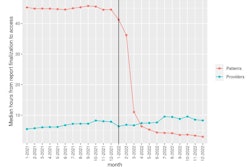
A provision of the 21st Century Cures Act of 2016 took effect earlier this year after several delays and postponements. As of April 5, 2021, providers found guilty of "information blocking" could be subject to significant penalties of up to $1 million per occurrence, although the specifics regarding the process for awarding those penalties have yet to be finalized by the Office of the Inspector General (OIG) in the U.S. Department of Health and Human Services.
 Sandy Coffta.
Sandy Coffta.The intent of the law is to promote the free flow of relevant healthcare information between providers and to ensure that patients can access their own information where and when they need it. A better name might have been the "information sharing" or "anti-information blocking" law!
Overview of the law
The information blocking law is aimed at electronic health information (EHI), and it describes "blocking" as an action by a healthcare provider, health IT developer of certified health IT, health information network (HIN), or health information exchange (HIE) that is likely to interfere with the access, exchange, or use of EHI.
Much of the burden of the new law is on software developers to assure their medical practice customers that their system is in compliance, but it is ultimately the responsibility of the practice to be in control of this situation.
The following data elements must be made available to patients upon their request:
- Patient demographics
- Care team members
- Clinical notes, which encompasses imaging and lab reports as well as consultation notes, procedure notes, history and physical, and progress notes.
- Procedures
- Laboratory tests and results
- Problems such as information about a condition, diagnosis, or other event, situation, issue, or clinical concept that is documented.
- Health concerns
- Assessment and plan of treatment
- Vital signs
- Goals
- Immunizations
- Medications
- Allergies and intolerances
- Smoking status
- Unique device identifiers for a patient's implantable devices
- Provenance (metadata associated with the EHI)
Many of the elements listed above are irrelevant to radiology practice, so it is important to note that the practice is only required to report the data elements that it has captured. For example, it would not be considered information blocking if the patient's "smoking status" was not captured and thus not made available.
Exceptions to avoid a penalty
A medical practice might violate the new law if they knowingly take actions that interfere with a patient's EHI, even if no harm is caused. This could even include a practice's delay in responding to a patient's request for access to their information.
However, there are two categories of exceptions that avoid the penalty even if an action would otherwise be considered information blocking:
Category 1 -- Exceptions that involve not fulfilling requests to the access, exchange, or use of EHI. These include preventing harm, privacy, security, infeasibility, and health IT performance.
Category 2 -- Exceptions that involve procedures for fulfilling requests to the access, exchange, or use of EHI. These describe circumstances under which the practice may limit the content of a response or charge a fee without being considered information blocking.
Prepare your practice
The first step in preparing to comply with this law is to contact your EHI software vendor if they have not already informed the practice of their compliance. EHI vendors have been more aware of this law than practices have, so it is likely that your system already has the necessary safeguards.
A review of the practice's policies and procedures is an important next step, to be sure the staff knows how to respond properly to information requests. Many systems employ the use of a portal or personal app that the staff should be trained on so they can be ready to assist patients. If your practice has a policy of charging fees for patients' records, it should be reviewed with legal counsel to be sure you are not violating the information blocking rules.
Online resources are available from the American College of Radiology (ACR) and from the Medical Group Management Association (MGMA) to help your practice get ready. In particular, the ACR's Frequently Asked Questions discusses provisions of the law that pertain to radiology practices. It indicates that the issuance of radiology reports need not change due to the law, and that unfinalized data does not have to be released until it "is being used to make healthcare decisions about an individual." The ACR suggests that practices become familiar with the list of exceptions. For example, a radiology practice might not be able to satisfy certain requests due to limited technological capabilities and so the "infeasibility" or "content/manner" exceptions could come into play.
Conclusion
Some healthcare industry groups are calling on regulators to modify certain aspects of the law that they feel are harmful to patients, especially those related to the speed with which a response to a patient's request must be given. The argument is that patients can receive results and diagnoses before the physician has been able to review them and contact the patient personally, so a longer response window has been requested.
The ACR sees a benefit for radiologists and states that "the information blocking provision should help broadly advance data-sharing and interoperability, including in many ways that help radiology providers connect with referring providers."
The information blocking law carries serious penalties for noncompliance, and some of its provisions are easily triggered if your practice is not aware of them. We will continue to monitor any updates to this regulation, especially as the penalty provisions will soon be finalized and some of its other provisions are subject to revision in 2022.
Sandy Coffta is the vice president of client services at Healthcare Administrative Partners.
The comments and observations expressed are those of the author and do not necessarily reflect the opinions of AuntMinnie.com.



















